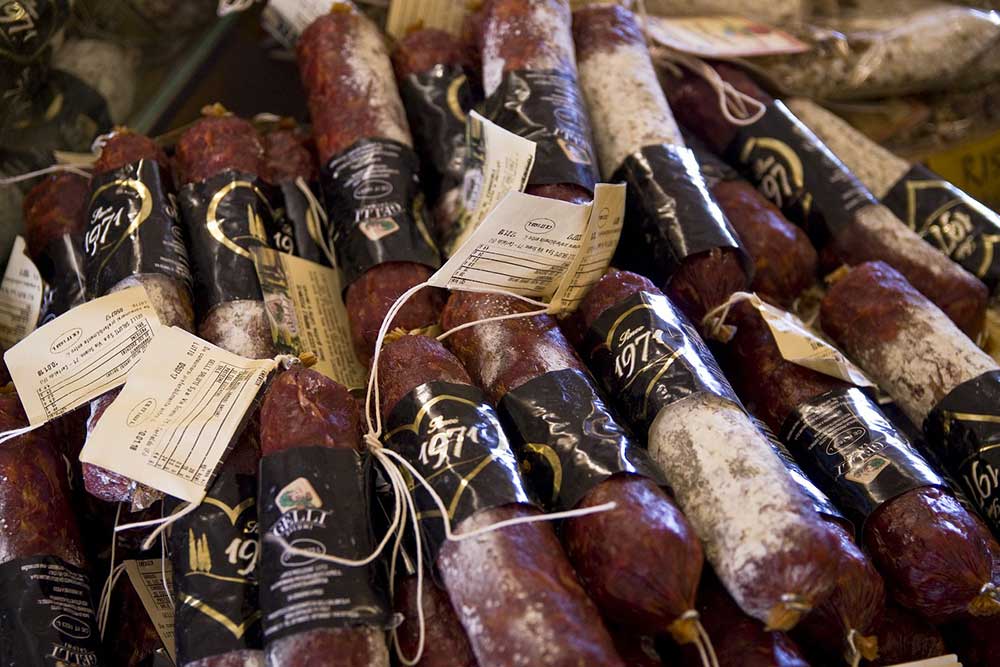
Salami, a cured sausage originating from Italy, is a staple in both everyday meals and gourmet dining. This ancient meat preservation technique has a rich history, steeped in tradition and culinary craftsmanship. It is known for its complex flavor, unique texture, and variety of styles, making it one of the most versatile cured meats in the world. From casual antipasti platters to fine dining charcuterie boards, salami has earned its place in Italian cuisine and beyond.
The word "salami" is derived from the Latin word "salumen," which means "salted meat." Historically, salting and air-drying meats were essential preservation techniques in pre-refrigeration times, ensuring that food could be stored for long periods. Salami, in particular, dates back to ancient Rome, where it became an essential part of the Mediterranean diet.
Italy's geographical diversity has greatly influenced the evolution of salami, with each region developing its own distinct styles. Northern regions like Emilia-Romagna and Lombardy are known for their finely ground, delicate varieties, while the southern regions such as Calabria produce spicier, coarser types of salami, reflecting their local ingredients and climate.
Italian salami comes in numerous varieties, each with its own set of characteristics depending on the ingredients, meat cuts, spices, and curing methods. Here are some of the most notable types:
One of the most popular types, Salami Milano, is a finely ground pork salami flavored with garlic, pepper, and white wine. Its smooth texture and mild flavor make it a favorite for sandwiches and antipasti.
Hailing from Tuscany, this type is coarser in texture and packed with flavors of fennel, garlic, and black pepper. The spices in Salami Toscano give it a more robust flavor, reflecting the Tuscan culinary tradition of bold, earthy ingredients.
A traditional salami from southern Italy, Soppressata has a rough, uneven texture and is often spiced with hot red pepper flakes, giving it a spicy kick. The pork is less finely ground, resulting in a heartier bite.
Famous for its distinctive flavor, Finocchiona is made with fennel seeds, which were traditionally used as a substitute for pepper in Tuscany. This salami is soft and aromatic, with the fennel imparting a sweet, licorice-like flavor.
This variety is a blend of lean pork and pork fat, flavored with black pepper and garlic, then smoked for a unique depth of flavor. Salami Napoli is often spicier, with a rustic, robust character that pairs well with hard cheeses and bold wines.
The process of making salami is both an art and a science, requiring skilled craftsmanship and patience. Here's an overview of how traditional Italian salami is produced:
Salami is typically made from pork, but beef or a mixture of meats can also be used. The cuts of meat are important; a balance of lean meat and fat ensures the right texture and flavor.
The meat is coarsely or finely ground, depending on the type of salami being made. The ground meat is then mixed with salt, spices, and sometimes wine, which not only flavors the salami but also acts as a natural preservative.
The seasoned meat mixture is stuffed into natural or synthetic casings, giving the salami its characteristic sausage shape. At this stage, the salami is raw and requires curing to develop its final flavor.
Fermentation is a crucial part of the salami-making process. The sausages are hung in a controlled environment, where beneficial bacteria convert the sugars in the meat into lactic acid. This step gives salami its tangy flavor and contributes to its preservation. After fermentation, the salami is air-dried for several weeks to months, depending on the type.
The final aging stage allows the flavors to deepen and develop. The length of time salami is aged can vary greatly, with some types of salami aged for over a year to achieve a more intense flavor.
Salami holds a special place in Italian food culture, not just as a culinary item but as a symbol of tradition and regional pride. Each region fiercely guards its recipes and techniques, and many types of salami are granted Protected Designation of Origin (PDO) status by the European Union. This designation ensures that the salami is made using specific, traditional methods in a particular geographic area.
In Italian households, salami is a staple, often enjoyed as part of a light lunch with bread and cheese or as an appetizer paired with wine. Its versatility means it can be sliced thin for sandwiches, diced for pasta dishes, or enjoyed as a savory snack on its own.
Italian salami is more than just a cured meat—it's a product of centuries of culinary expertise, regional heritage, and artisanal craftsmanship. Whether you prefer the mild, delicate flavors of Salami Milano or the spicy, bold taste of Soppressata, there's a type of salami for every palate. Next time you enjoy a slice, you’ll know you’re savoring a piece of Italy's rich cultural and gastronomic history.

More Details